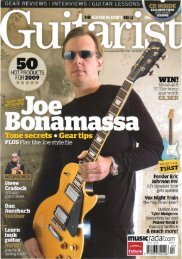Create successful ePaper yourself
Turn your PDF publications into a flip-book with our unique Google optimized e-Paper software.
COVER STORY <strong>Joe</strong> <strong>Bonamassa</strong><br />
wing and out on the road, providing lessons<br />
and advice. The guidance <strong>Bonamassa</strong> got<br />
from these two kingpins, along with jam<br />
sessions with a who’s-who of blues gods,<br />
spurred him on to practice his ass off, study<br />
his music hi<strong>story</strong>, get his sound together,<br />
and make a go of it.<br />
<strong>Bonamassa</strong> is more right than he knows<br />
when he says he’s good for his age. That was<br />
true when he was 11 and it’s even truer now.<br />
Even though he’s just in his 30s, he’s been<br />
gigging for 20 years and he has the depth<br />
and power in his playing of someone with a<br />
lot more miles on him. He’s an old soul, and<br />
that comes through in his bends, vibrato,<br />
singing voice, and note choices, which—with<br />
each passing year—get more restrained and<br />
refined.<br />
<strong>Bonamassa</strong> is also good for his age in the<br />
sense that he’s good for his era. He embodies<br />
a refreshing work ethic and outlook on<br />
life that says no matter how fortunate you are,<br />
how many breaks you’re given, or how much<br />
god-given talent you possess, it doesn’t mean<br />
you don’t have to work at it. He knows there<br />
is no free lunch (despite the fact that B.B.<br />
King once gave him half of his sandwich).<br />
He’s a dude who is willing to work for a living.<br />
He’s not chasing fame or glitz or glam.<br />
1958 Gibson<br />
ES-140T<br />
82 APRIL 2009 GUITAR PLAYER<br />
He wants to get a good sound, take a good<br />
solo, and hopefully make people happy along<br />
the way.<br />
His formula is paying off. He has worked<br />
with celebrated producers Tom Dowd<br />
(Coltrane, Cream, Clapton, Allmans, etc)<br />
and Kevin Shirley (Black Crowes, Aerosmith,<br />
Led Zeppelin). His last two albums have<br />
debuted at number one on the Billboard blues<br />
chart. He has won GP’s Readers’ Poll award<br />
for Best Blues Guitarist two years running,<br />
famously tying none other than Buddy Guy<br />
one of those years. His tours have gotten<br />
stronger every year, although he still prefers<br />
the B.B. King-approved theater circuit to<br />
stadiums. It makes perfect sense that <strong>Bonamassa</strong>’s<br />
new record would be called The Ballad<br />
of John Henry [J&R Adventures], because <strong>Bonamassa</strong><br />
is a modern-day working-class hero.<br />
Conducting this interview from the very<br />
bedroom in upstate New York where he<br />
learned how to play guitar at the age of four,<br />
<strong>Bonamassa</strong> obviously has not forgotten<br />
where he came from. He’s good for his age.<br />
He’s good for this age.<br />
Lots of guys can play good blues in a bar, but very<br />
few can make a studio blues record that has 1/10th<br />
of that energy or vibe. How do you pull it off?<br />
It is very difficult to capture that energy<br />
in a studio. The studio tends to be a very<br />
sterile environment by design. Every track<br />
is separated. You get perfect separation of<br />
the toms, the kick and the snare, perfect separation<br />
between the guitar and the bass, and<br />
obviously the vocal. And that’s not really<br />
what blues music sounds like. There are people<br />
out there who believe that what I play is<br />
not blues, but think about blues-based music,<br />
like Jeff Beck’s Truth, Tons of Sobs by Free, Led<br />
Zeppelin I, The Hard Road by John Mayall’s<br />
Bluesbreakers with Peter Green, the “Beano”<br />
album. These are my favorite albums of all<br />
time in the blues-rock genre and they all<br />
have this one common trait: Everything melts<br />
together. The drums melt into the bass, the<br />
bass and drums melt into the guitar, the vocal<br />
is panned to one side with the reverb return<br />
on the other. To Kevin Shirley’s credit, he<br />
allows for all that. Kevin deserves most of<br />
the credit on these albums. He’s the guy who<br />
spearheads the vision, takes me out of my<br />
comfort zone, and forces me to play different<br />
stuff. He also engineers the whole thing<br />
so that it has the sound of a live band in a<br />
room, but is separated enough that it doesn’t<br />
sound lo-fi. So, that’s my secret: I hire a guy<br />
named Kevin Shirley.<br />
1950 Gibson ES-5 1961 Guild X-375 Early-’60s Airline 1953 Hoyer<br />
Regent<br />
PHOTOS:RICK GOULD




